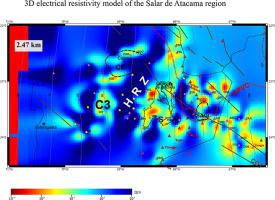Physics of the Earth and Planetary Interiors ( IF 2.3 ) Pub Date : 2021-06-19 , DOI: 10.1016/j.pepi.2021.106765 Katarzyna Ślęzak , Daniel Díaz , Jaime Araya Vargas , Darcy Cordell , Felipe Reyes-Cordova , María José Segovia

|
The Salar de Atacama region (23°-24°S) in the Central Andes of northern Chile represents an anomalous segment of the Andes, where a very large forearc basin is present (Salar de Atacama) and the axis of the active volcanic chain is deflected to the east from its regional trend. Here we used magnetotelluric (MT) data to infer the distribution of partial melts and hydrothermal fluids in order to better understand the mechanism controlling the magmatism in this subduction zone.
Our 3-D inversion model shows a complex electrical resistivity structure, with several mid crustal conductors (<5 Ωm) imaged around the Salar de Atacama basin (SdAb). Although the forearc is dominated by high resistivities (>1000 Ωm), conductors were imaged below the Precordillera and in the northern SdAb, where major trench-parallel and transverse fault systems are present. We interpret these forearc conductors as evidence of active and fossil hydrothermal systems hosted by the Precordillera Fault System and the Calama-Olacapato-El Toro transverse fault. Conductors found along the arc are spatially coincident with active volcanoes likely representing partial melting in the continental crust. A large conductor was imaged in the backarc, indicating the presence of a significant volume of partial melts below the Altiplano-Puna plateau, as many previous geophysical studies have suggested. The model shows that the mid-lower crust and subcontinental mantle (i.e., >15 km depth) below the SdAb is dominated by resistivity values >100 Ωm., suggesting the presence of a relatively poorly hydrated continental crust and mantle wedge in this segment of the northern Chile subduction zone. These results, together with petrophysical interpretations derived from previous seismic and gravimetric studies, suggest that the lithosphere below the SdAb represents an impermeable block, which inhibits the upward flow of fluids and melts derived from deeper parts of the subduction system.
中文翻译:

Salar de Atacama 地区(23°-24°S)智利俯冲带的大地电磁图像:洞察控制火山弧岩浆分布的因素。
智利北部安第斯山脉中部的阿塔卡马盐沼地区(23°-24°S)代表了安第斯山脉的一个异常段,那里有一个非常大的弧前盆地(阿塔卡马盐沼),活火山链的轴线是从区域趋势向东偏转。在这里,我们使用大地电磁 (MT) 数据来推断部分熔体和热液的分布,以更好地了解控制该俯冲带岩浆活动的机制。
我们的 3-D 反演模型显示了一个复杂的电阻率结构,在阿塔卡马盐沼 (SdAb) 周围成像了几个中地壳导体 (<5 Ωm)。尽管前弧以高电阻率 (>1000 Ωm) 为主,但在 Precordillera 下方和 SdAb 北部对导体进行了成像,其中存在主要的沟渠平行和横向断层系统。我们将这些前弧导体解释为由 Precordillera 断层系统和 Calama-Olacapato-El Toro 横向断层承载的活动和化石热液系统的证据。沿弧线发现的导体在空间上与可能代表大陆地壳部分熔化的活火山重合。在弧后成像了一个大导体,表明在 Altiplano-Puna 高原下方存在大量部分熔体,正如许多以前的地球物理研究所表明的那样。该模型表明,SdAb 下方的中下地壳和次大陆地幔(即 >15 km 深度)以电阻率值 >100 Ωm 为主,表明该段存在水合相对较差的大陆地壳和地幔楔。智利北部俯冲带。这些结果与先前地震和重力研究得出的岩石物理解释一起表明,SdAb 下方的岩石圈代表了一个不可渗透的块体,它抑制了来自俯冲系统更深部分的流体和熔体的向上流动。这表明在智利北部俯冲带的这一部分存在水化相对较差的大陆地壳和地幔楔。这些结果与先前地震和重力研究得出的岩石物理解释一起表明,SdAb 下方的岩石圈代表了一个不可渗透的块体,它抑制了来自俯冲系统更深部分的流体和熔体的向上流动。这表明在智利北部俯冲带的这一部分存在水化相对较差的大陆地壳和地幔楔。这些结果与先前地震和重力研究得出的岩石物理解释一起表明,SdAb 下方的岩石圈代表了一个不可渗透的块体,它抑制了来自俯冲系统更深部分的流体和熔体的向上流动。


























 京公网安备 11010802027423号
京公网安备 11010802027423号